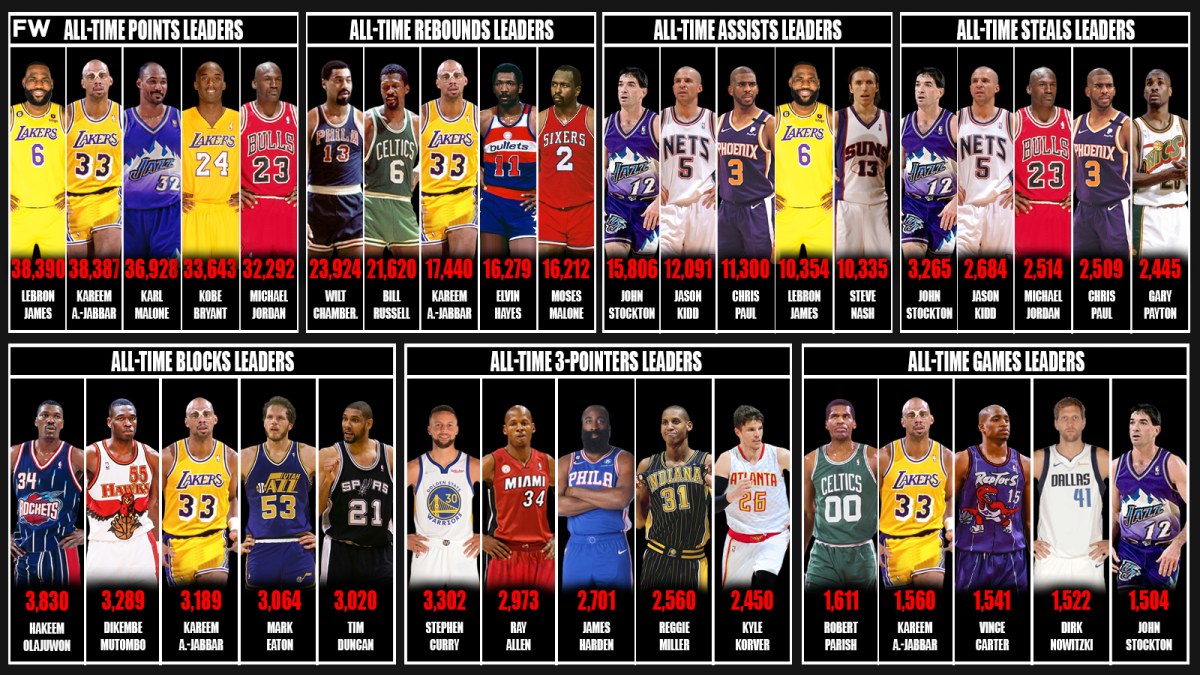
Decoding the Numbers: A Deep Dive into NBA Player Stats and Rankings
The National Basketball Association (NBA) is a league defined by numbers. Beyond the wins and losses, the true story of a season, a player’s career, and even a single game unfolds in a complex tapestry of statistics. Understanding these statistics is key to appreciating the nuances of the game, evaluating player performance, and ultimately, enjoying the NBA on a deeper level. This article will delve into the most important NBA statistics, exploring their significance, limitations, and how they contribute to various ranking systems.
Traditional Statistics: The Foundation
For decades, traditional statistics like points, rebounds, assists, steals, and blocks formed the backbone of player evaluation. While seemingly straightforward, these numbers offer valuable insights:
-
Points (PTS): The most widely recognized stat, points reflect a player’s scoring prowess. High point totals indicate a player’s ability to score efficiently and consistently. However, points alone don’t tell the whole story. A player scoring 30 points on 20 shots is less efficient than a player scoring 25 points on 15 shots.
-
Rebounds (REB): Rebounds, both offensive (OREB) and defensive (DREB), showcase a player’s ability to secure possession after a missed shot. Offensive rebounds lead to second-chance opportunities, while defensive rebounds prevent opponents from scoring. Centers and power forwards typically lead the league in rebounding.
-
Assists (AST): Assists measure a player’s ability to set up teammates for scoring opportunities. High assist numbers indicate a player’s court vision, passing skills, and ability to create scoring chances for their teammates. Point guards typically lead the league in assists.
-
Steals (STL): Steals represent a player’s ability to disrupt the opponent’s offense by intercepting passes. Steals highlight defensive awareness, quickness, and anticipation.
-
Blocks (BLK): Blocks showcase a player’s ability to alter shots at the rim. Players with high block totals often possess size, athleticism, and timing. Centers are usually the league leaders in blocks.
Advanced Statistics: Unveiling a Deeper Understanding
While traditional statistics provide a basic understanding of player performance, advanced metrics offer a more nuanced and comprehensive perspective. These statistics often take into account context and efficiency, painting a clearer picture of a player’s impact on the game:
-
Player Efficiency Rating (PER): PER is a single number that attempts to summarize a player’s per-minute statistical production. While not perfect, it provides a useful overall measure of a player’s efficiency.
-
True Shooting Percentage (TS%): TS% accounts for all scoring attempts (field goals, free throws, and three-pointers), providing a more accurate measure of shooting efficiency than field goal percentage alone.
-
Effective Field Goal Percentage (eFG%): eFG% adjusts field goal percentage to account for the extra value of three-pointers, giving a more accurate representation of a player’s shooting ability.
-
Usage Rate (USG%): USG% represents the percentage of team plays used by a player while they are on the court. High usage rates can indicate a player’s offensive dominance, but they can also suggest inefficiency if the player isn’t converting those possessions into points.
-
Win Shares (WS): Win Shares attempts to quantify a player’s contribution to team wins. It considers various factors, including scoring, rebounding, assists, and defense.
-
Box Plus/Minus (BPM): BPM estimates a player’s contribution per 100 possessions, accounting for both offensive and defensive performance. A positive BPM indicates a player is adding value to their team, while a negative BPM suggests the opposite.
-
Value Over Replacement Player (VORP): VORP measures a player’s contribution relative to a replacement-level player. It helps to assess a player’s overall value to the team.
Ranking Systems: Putting it All Together
Numerous websites and analysts use various combinations of traditional and advanced statistics to create player rankings. These rankings often reflect different philosophies and priorities:
-
ESPN’s Real Plus-Minus (RPM): RPM is a comprehensive rating system that takes into account a player’s performance in various situations and against different opponents.
-
FiveThirtyEight’s RAPTOR: RAPTOR uses a machine-learning algorithm to predict player performance, incorporating a wide range of data points.
-
Basketball-Reference.com’s various metrics: Basketball-Reference offers a wealth of data and statistical tools, allowing users to explore various rankings and metrics based on different preferences.
These ranking systems, while helpful, should be interpreted cautiously. No single metric or ranking system can perfectly capture the complexity of a player’s contribution to the game. Context is crucial. A player’s ranking might vary depending on the system used, the team they play for, and the specific opponents they face.
Limitations of Statistics
It’s essential to acknowledge the limitations of statistics. While numbers offer valuable insights, they can’t fully capture the intangible aspects of basketball, such as leadership, hustle, teamwork, and defensive intensity. A player might not have outstanding statistics but still make significant contributions through their intangible qualities. Furthermore, statistical analysis should always be considered within the context of the player’s role within their team and the specific style of play.
Conclusion
NBA player stats and rankings provide a fascinating lens through which to analyze and appreciate the game. While traditional statistics offer a foundational understanding, advanced metrics offer a richer and more nuanced perspective. By understanding the strengths and limitations of different statistics and ranking systems, fans can gain a deeper appreciation for the skill, talent, and strategic depth of the NBA. Ultimately, the best approach to evaluating NBA players involves considering a variety of statistics and contextual factors, recognizing that numbers alone can’t tell the whole story. They offer a powerful tool for analysis, but the human element of the game remains irreplaceable.



